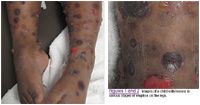Bullous insect bite reaction
A case study of a young child who presented with a bullous insect reaction.
DERMATOLOGY: What's your Dx?

Vignettes are based on real cases which have been modified to allow the authors and editor to focus on key teaching points. Images may also be edited or substituted for teaching purposes.
Diagnosis: Bullous insect bite reaction
Clinical findings
Both type I and type IV hypersensitivity may play a role in insect bite reactions. The immune response is against protein antigens present in insect saliva.1-3 These reactions occur in individuals bitten by a number of blood-sucking insects, most commonly cat fleas, dog fleas, bed bugs, and mosquitoes.
Classic insect bite hypersensitivity reactions or papular urticaria are characterized by the eruption of uniform 3- to 5-mm edematous red papules with a central crust, often following a wheal reaction.2,3 A central vesicle may form before scratching results in crusting. In some children the bullous reaction may predominate. The development of papular urticaria peaks in children from ages 2 to 10 years. Early during the induction period (which may last months to years) and the following tolerance (which develops in most children over a period of years), little or no reaction may occur in the skin.
Although any part of the skin may be involved, lesions tend to be most dense in areas where the biting insects have access. In crawling infants the face, neck, arms, and legs are most likely to be involved, with invariable sparing of the diaper area. In ambulatory children lesions may be limited to the feet and legs.
Papular urticaria tends to recur during the summer months when the population of biting insects peaks. However, cat fleas may move indoors and trigger chronic and recurrent eruptions all year round.
Differential diagnosis
Bullous impetigo produces superficial vesicles and bullae that rupture almost immediately, resulting in clusters of variably sized crusts with expanding vesicular borders. Purulent debris is usually noted, smears are positive for gram-positive cocci, and cultures usually grow Staphylococcus aureus. Unless secondarily infected, the bullae associated with insect bite reactions are sterile, located deeper in the epidermis, and tend to be tense.
Acute contact dermatitis can result in tense intraepidermal vesicles and bullae, but they vary in size, arise on an eczematous base, and tend to be irregularly shaped and angulated.
The eruption of chronic bullous disease of childhood-an autoimmune bullous disorder-presents with diffuse, symmetric variably sized vesicles and bullae on a red or normal skin base. The bullae are usually tense, and mucous membranes may be involved. Although rare, this group of disorders should be considered when cultures are negative, mucous membranes are involved, and/or children do not respond to protective and therapeutic measures.
Treatment
Treatment of papular urticaria is symptomatic with cool tap water compresses, topical corticosteroids, and oral antihistamines. Localized secondary infection can be managed with topical antibiotics, but widespread infection is best treated with oral antibiotics. Coverage for methicillin-resistant Staphylococcus aureus (MRSA) should be considered in communities where MRSA is prevalent.
Parents are often skeptical of the diagnosis of an exaggerated response to insect bites, especially since other children in the household are often unaffected. Convincing parents is vital for compliance of preventive measures. Preventive measures including protective clothing and insect repellents may be effective in reducing the number of new lesions. Treatment of infested pets, carpeting, and bedding is also recommended.